Beispiel für OAuth2 Social Login im Spring Boot
1. Das Zweck der Unterricht
Der traditionale Weg zum Zugang auf einer gesicherten Webseite ist, dass der Benutzer ein Konto erstellen braucht, dann geht in seinem Email um das Konto zu aktivieren, speichert den Anmeldungsname und Passwort. Die meiste Benutzer vergisst oft diese Information nach einer Zeit. Die Information, die der Benutzer zur Kontoerstellung eingeben muss, macht ihn manchmal entmultig.

Der Zugang auf website via social Netwerk ist ein ziemlich üblicher Weg, der von der meisten website benutzt wird. Durch diesen Weg kann der Benutzer ein Konto auf Ihrer website schnell machen. Ihre Applikation braucht ihm email zu Aktivation nicht schicken
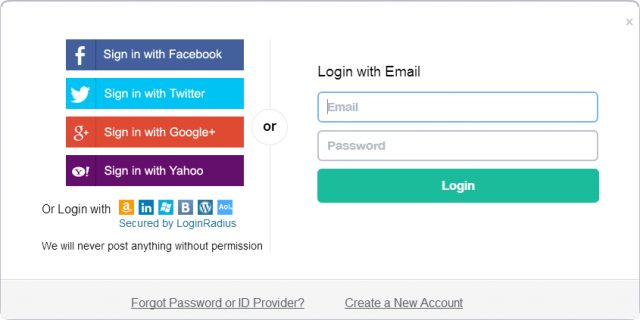
Bei diesem ersten Mal benutzt der Benutzer sein sociales Netwert um in Ihre website anzumelden, haben Sie 3 unterschiedliche Auswählen.
- Die Option 1: Ihr soziales Netwerk Konto wird akzeptiert werden und Ihre website tut keine anderen Aktionen.
- Die Option 2: Nach der public Information auf dem sozialen Netwerk vom Benutzer wird Ihre website automatisch ein entsprechendes Konto bilden.
- Die Option 3: Ihre Website leitet dem Benutzer nach der Registrationsseite mit der Defaultinformation, die von seinem sozialen Netwerk Konto erhaltet, weiter. Das hilft dem Benutzer, alle Information nicht einzugeben.
In dieser Unterricht werde ich eine Applikation mit Spring Boot + JPA + Spring Social Security erstellen. Unten ist das die Vorschau der Applikation.
Die Auswahl 2:
Falls der Benutzer zum ersten Mal in dem soziellen Netwerk an, wird ein Rekord APP_USER mit dem durch System erstellten automatische User_Name automatisch erstellt.
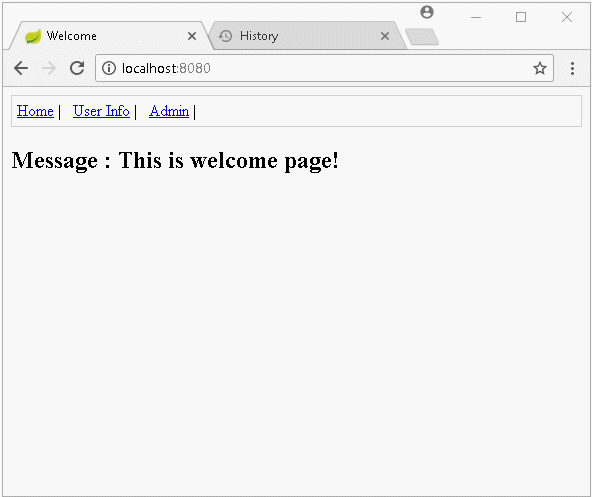
Die Auswahl 3:
Falls der Benutzer via soziales Netwerk angemeldet hat, leitet das System dem Benutzer nach der Registrationsseite mit der Defaultinformation, die von seinem Sozialen Netwerkskonto erhaltet hat. Der Benutzer kann die Information User_Name, First Name, Last Name, ... ändern. Danach klicken Sie auf "Submit" , wird ein Rekord APP_USER erstellt
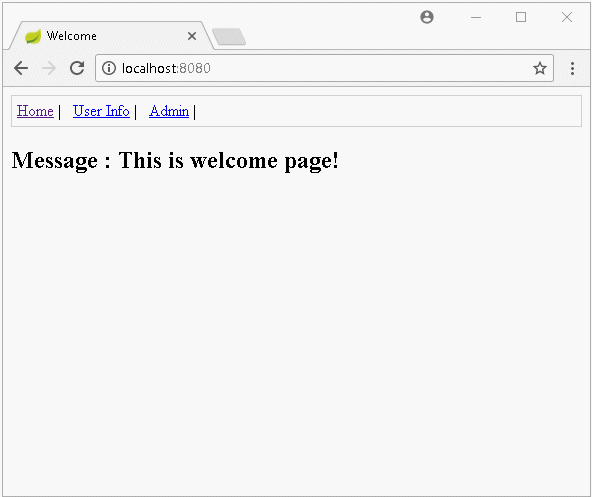
2. Das Projekt Spring Boot erstellen
Auf Eclipse erstellen Sie ein Projekt Spring Boot.
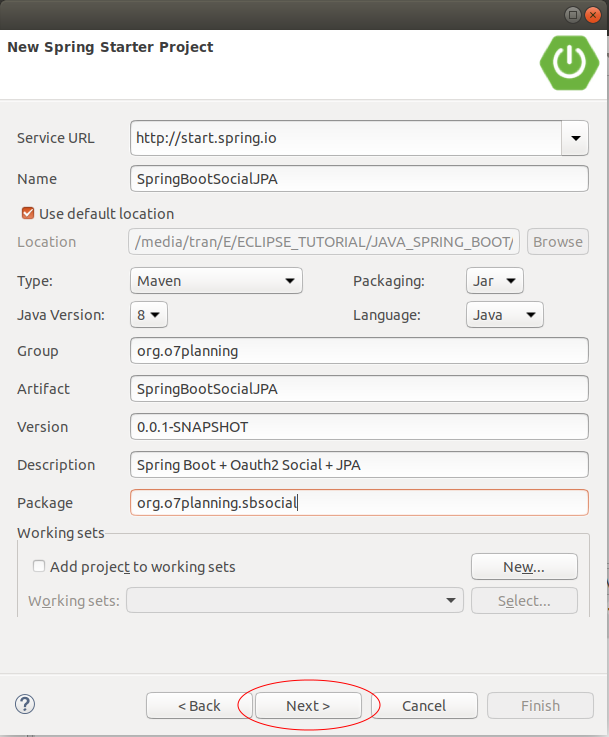
Die Database, die in dieser Applikation benutzt werden, sind MySQL, SQL Server, PostGres oder Oracle oder eine andere Database, die Ihnen bekannt vorkommt.
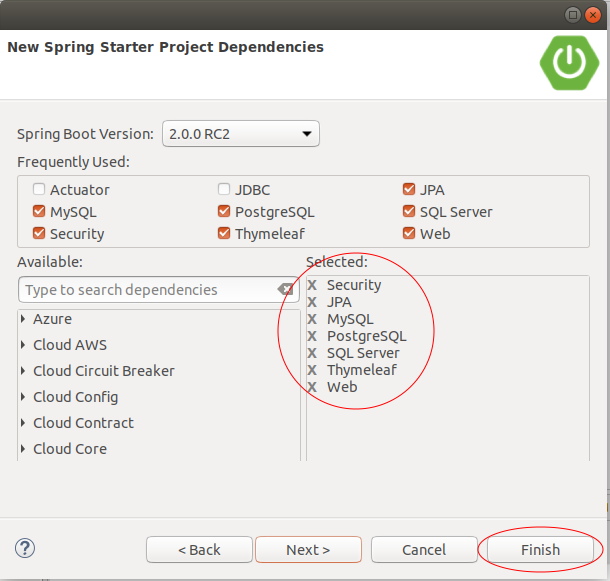
Die Bibliotheke Spring Social in Ihr Projekt deklarieren:
- spring-security-oauth2
- spring-social-core
- spring-social-config
- spring-social-security
- spring-social-facebook
- spring-social-twitter
- spring-social-github
- spring-social-linkedin
- spring-social-google
Die volle Inhalte der File pom.xml:
pom.xml
<?xml version="1.0" encoding="UTF-8"?>
<project xmlns="http://maven.apache.org/POM/4.0.0"
xmlns:xsi="http://www.w3.org/2001/XMLSchema-instance"
xsi:schemaLocation="http://maven.apache.org/POM/4.0.0
http://maven.apache.org/xsd/maven-4.0.0.xsd">
<modelVersion>4.0.0</modelVersion>
<groupId>org.o7planning</groupId>
<artifactId>SpringBootSocialJPA</artifactId>
<version>0.0.1-SNAPSHOT</version>
<packaging>jar</packaging>
<name>SpringBootSocialJPA</name>
<description>Spring Boot + Oauth2 Social + JPA</description>
<parent>
<groupId>org.springframework.boot</groupId>
<artifactId>spring-boot-starter-parent</artifactId>
<version>2.0.0.RELEASE</version>
<relativePath /> <!-- lookup parent from repository -->
</parent>
<properties>
<project.build.sourceEncoding>UTF-8</project.build.sourceEncoding>
<project.reporting.outputEncoding>UTF-8</project.reporting.outputEncoding>
<java.version>1.8</java.version>
</properties>
<dependencies>
<dependency>
<groupId>org.springframework.boot</groupId>
<artifactId>spring-boot-starter-data-jpa</artifactId>
</dependency>
<dependency>
<groupId>org.springframework.boot</groupId>
<artifactId>spring-boot-starter-security</artifactId>
</dependency>
<dependency>
<groupId>org.springframework.boot</groupId>
<artifactId>spring-boot-starter-thymeleaf</artifactId>
</dependency>
<dependency>
<groupId>org.springframework.boot</groupId>
<artifactId>spring-boot-starter-web</artifactId>
</dependency>
<!-- http://mvnrepository.com/artifact/org.springframework.security/spring-security-config -->
<dependency>
<groupId>org.springframework.security</groupId>
<artifactId>spring-security-config</artifactId>
</dependency>
<!-- https://mvnrepository.com/artifact/org.springframework.security.oauth/spring-security-oauth2 -->
<dependency>
<groupId>org.springframework.security.oauth</groupId>
<artifactId>spring-security-oauth2</artifactId>
<version>2.2.1.RELEASE</version>
</dependency>
<!-- https://mvnrepository.com/artifact/org.springframework.social/spring-social-core -->
<dependency>
<groupId>org.springframework.social</groupId>
<artifactId>spring-social-core</artifactId>
<version>1.1.5.RELEASE</version>
</dependency>
<!-- https://mvnrepository.com/artifact/org.springframework.social/spring-social-config -->
<dependency>
<groupId>org.springframework.social</groupId>
<artifactId>spring-social-config</artifactId>
<version>1.1.5.RELEASE</version>
</dependency>
<!-- https://mvnrepository.com/artifact/org.springframework.social/spring-social-web -->
<dependency>
<groupId>org.springframework.social</groupId>
<artifactId>spring-social-web</artifactId>
<version>1.1.5.RELEASE</version>
</dependency>
<!-- https://mvnrepository.com/artifact/org.springframework.social/spring-social-security -->
<dependency>
<groupId>org.springframework.social</groupId>
<artifactId>spring-social-security</artifactId>
<version>1.1.5.RELEASE</version>
</dependency>
<!-- https://mvnrepository.com/artifact/org.springframework.social/spring-social-facebook -->
<dependency>
<groupId>org.springframework.social</groupId>
<artifactId>spring-social-facebook</artifactId>
<version>2.0.3.RELEASE</version>
</dependency>
<!-- https://mvnrepository.com/artifact/org.springframework.social/spring-social-twitter -->
<dependency>
<groupId>org.springframework.social</groupId>
<artifactId>spring-social-twitter</artifactId>
<version>1.1.2.RELEASE</version>
</dependency>
<!-- https://mvnrepository.com/artifact/org.springframework.social/spring-social-github -->
<!-- <dependency>
<groupId>org.springframework.social</groupId>
<artifactId>spring-social-github</artifactId>
<version>1.0.0.M4</version>
</dependency> -->
<!-- https://mvnrepository.com/artifact/org.springframework.social/spring-social-linkedin -->
<dependency>
<groupId>org.springframework.social</groupId>
<artifactId>spring-social-linkedin</artifactId>
<version>1.0.2.RELEASE</version>
</dependency>
<!-- https://mvnrepository.com/artifact/org.springframework.social/spring-social-google -->
<dependency>
<groupId>org.springframework.social</groupId>
<artifactId>spring-social-google</artifactId>
<version>1.0.0.RELEASE</version>
</dependency>
<dependency>
<groupId>mysql</groupId>
<artifactId>mysql-connector-java</artifactId>
<scope>runtime</scope>
</dependency>
<dependency>
<groupId>org.postgresql</groupId>
<artifactId>postgresql</artifactId>
<scope>runtime</scope>
</dependency>
<dependency>
<groupId>com.oracle</groupId>
<artifactId>ojdbc6</artifactId>
<version>11.2.0.3</version>
</dependency>
<!-- SQL Server Mssql-Jdbc Driver -->
<dependency>
<groupId>com.microsoft.sqlserver</groupId>
<artifactId>mssql-jdbc</artifactId>
<scope>runtime</scope>
</dependency>
<!-- SQL Server JTDS Driver -->
<!-- https://mvnrepository.com/artifact/net.sourceforge.jtds/jtds -->
<dependency>
<groupId>net.sourceforge.jtds</groupId>
<artifactId>jtds</artifactId>
<version>1.3.1</version>
</dependency>
<!-- Email validator,... -->
<!-- http://mvnrepository.com/artifact/commons-validator/commons-validator%20 -->
<dependency>
<groupId>commons-validator</groupId>
<artifactId>commons-validator</artifactId>
<version>1.5.0</version>
</dependency>
<dependency>
<groupId>org.springframework.boot</groupId>
<artifactId>spring-boot-starter-test</artifactId>
<scope>test</scope>
</dependency>
<dependency>
<groupId>org.springframework.security</groupId>
<artifactId>spring-security-test</artifactId>
<scope>test</scope>
</dependency>
</dependencies>
<repositories>
<!-- Repository for ORACLE JDBC Driver -->
<repository>
<id>codelds</id>
<url>https://code.lds.org/nexus/content/groups/main-repo</url>
</repository>
</repositories>
<build>
<plugins>
<plugin>
<groupId>org.springframework.boot</groupId>
<artifactId>spring-boot-maven-plugin</artifactId>
</plugin>
</plugins>
</build>
</project>SpringBootSocialJpaApplication.java
package org.o7planning.sbsocial;
import org.springframework.boot.SpringApplication;
import org.springframework.boot.autoconfigure.SpringBootApplication;
@SpringBootApplication
public class SpringBootSocialJpaApplication {
public static void main(String[] args) {
SpringApplication.run(SpringBootSocialJpaApplication.class, args);
}
}3. DataSource konfigurieren
Die Information über die Database, die in die File application.properties konfiguriert werden brauchen:
application.properties (MySQL)
spring.thymeleaf.cache=false
# ===============================
# DATABASE
# ===============================
spring.datasource.driver-class-name=com.mysql.jdbc.Driver
spring.datasource.url=jdbc:mysql://localhost:3306/social
spring.datasource.username=root
spring.datasource.password=12345
# ===============================
# JPA / HIBERNATE
# ===============================
spring.jpa.show-sql=true
spring.jpa.hibernate.ddl-auto=update
spring.jpa.properties.hibernate.dialect=org.hibernate.dialect.MySQL5Dialectapplication.properties (Mssql-Jdbc Driver)
spring.thymeleaf.cache=false
# ===============================
# DATABASE
# ===============================
spring.datasource.driver-class-name=com.microsoft.sqlserver.jdbc.SQLServerDriver
spring.datasource.url=jdbc:sqlserver://tran-vmware-pc\\SQLEXPRESS:1433;databaseName=social
spring.datasource.username=sa
spring.datasource.password=12345
# ===============================
# JPA / HIBERNATE
# ===============================
spring.jpa.show-sql=true
spring.jpa.hibernate.ddl-auto=update
spring.jpa.properties.hibernate.dialect=org.hibernate.dialect.SQLServer2012Dialectapplication.properties (PostGres)
spring.thymeleaf.cache=false
# ===============================
# DATABASE CONNECTION
# ===============================
spring.datasource.driver-class-name=org.postgresql.Driver
spring.datasource.url=jdbc:postgresql://tran-vmware-pc:5432/social
spring.datasource.username=postgres
spring.datasource.password=12345
# ===============================
# JPA / HIBERNATE
# ===============================
spring.jpa.show-sql=true
spring.jpa.hibernate.ddl-auto=update
spring.jpa.properties.hibernate.dialect=org.hibernate.dialect.PostgreSQLDialect
# Fix Postgres JPA Error:
# Method org.postgresql.jdbc.PgConnection.createClob() is not yet implemented.
spring.jpa.properties.hibernate.temp.use_jdbc_metadata_defaults=falseapplication.properties (Oracle)
spring.thymeleaf.cache=false
# ===============================
# DATABASE
# ===============================
spring.datasource.driver-class-name=oracle.jdbc.driver.OracleDriver
spring.datasource.url=jdbc:oracle:thin:@localhost:1521:db12c
spring.datasource.username=social
spring.datasource.password=12345
# ===============================
# JPA / HIBERNATE
# ===============================
spring.jpa.show-sql=true
spring.jpa.hibernate.ddl-auto=update
spring.jpa.properties.hibernate.dialect=org.hibernate.dialect.Oracle10gDialect4. Security & Spring Social konfigurieren
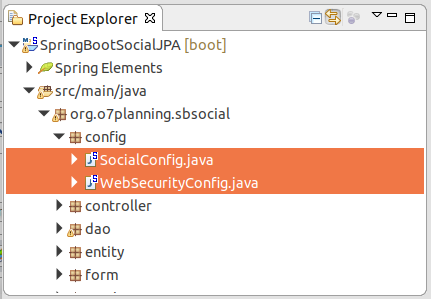
Spring Security konfigurieren:
WebSecurityConfig.java
package org.o7planning.sbsocial.config;
import org.o7planning.sbsocial.entity.AppRole;
import org.springframework.beans.factory.annotation.Autowired;
import org.springframework.context.annotation.Configuration;
import org.springframework.security.config.annotation.authentication.builders.AuthenticationManagerBuilder;
import org.springframework.security.config.annotation.web.builders.HttpSecurity;
import org.springframework.security.config.annotation.web.configuration.EnableWebSecurity;
import org.springframework.security.config.annotation.web.configuration.WebSecurityConfigurerAdapter;
import org.springframework.security.core.userdetails.UserDetailsService;
import org.springframework.social.security.SpringSocialConfigurer;
@Configuration
@EnableWebSecurity
public class WebSecurityConfig extends WebSecurityConfigurerAdapter {
@Autowired
private UserDetailsService userDetailsService;
@Autowired
public void configureGlobal(AuthenticationManagerBuilder auth) throws Exception {
auth.userDetailsService(userDetailsService);
}
@Override
protected void configure(HttpSecurity http) throws Exception {
http.csrf().disable();
// Pages do not require login
http.authorizeRequests().antMatchers("/", "/signup", "/login", "/logout").permitAll();
http.authorizeRequests().antMatchers("/userInfo").access("hasRole('" + AppRole.ROLE_USER + "')");
// For ADMIN only.
http.authorizeRequests().antMatchers("/admin").access("hasRole('" + AppRole.ROLE_ADMIN + "')");
// When the user has logged in as XX.
// But access a page that requires role YY,
// AccessDeniedException will be thrown.
http.authorizeRequests().and().exceptionHandling().accessDeniedPage("/403");
// Form Login config
http.authorizeRequests().and().formLogin()//
// Submit URL of login page.
.loginProcessingUrl("/j_spring_security_check") // Submit URL
.loginPage("/login")//
.defaultSuccessUrl("/userInfo")//
.failureUrl("/login?error=true")//
.usernameParameter("username")//
.passwordParameter("password");
// Logout Config
http.authorizeRequests().and().logout().logoutUrl("/logout").logoutSuccessUrl("/");
// Spring Social Config.
http.apply(new SpringSocialConfigurer())
//
.signupUrl("/signup");
}
// This bean is load the user specific data when form login is used.
@Override
public UserDetailsService userDetailsService() {
return userDetailsService;
}
}Damit der Benutzer via soziales Netwerk in Ihrer website anmelden kann, sollen Sie in jedem sozialen Netwerk die OAuth2 Zertifikate registrieren. Nach der Registration bekommen Sie ein Paar "Schlüssel + Passwort". Deklarieren Sie die Paare Schlüssel und Passwort in die File social-cfg.properties:
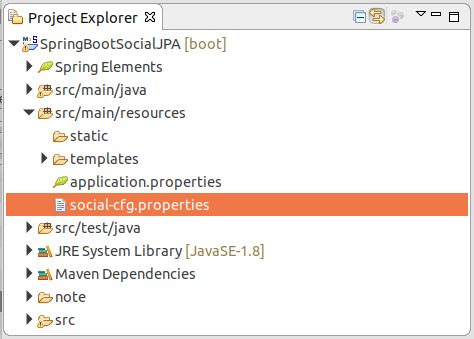
Unten habe ich die OAuth2 Zertifikate registriert damit die Applikation in einigen üblichen Sozialen Netwerk anmelden kann. Aber es funktioniert nur wenn die Applikation auf http://localhost:8080 läuft. Falls Sie die Applikation in anderen Domain oder Port laufen, sollen Sie Ihre eigenen Zertifikate registrieren.
social-cfg.properties
social.auto-signup=false
# Google
# http://localhost:8080/auth/google
google.client.id=160790488111-he5fn6rq0foqg05te70dk25gifeoum9s.apps.googleusercontent.com
google.client.secret=VILTmX1UjOnyw2_meYvDQEdl
google.scope=https://www.googleapis.com/auth/userinfo.email https://www.googleapis.com/auth/userinfo.profile
# Facebook
# http://localhost:8080/auth/facebook
facebook.app.id=1084911261562762
facebook.app.secret=81a324fdbc4cade1ee25523c7bff58b3
facebook.scope=public_profile,email
# Twitter
# http://localhost:8080/auth/twitter
twitter.consumer.key=
twitter.consumer.secret=
twitter.scope=
# Linkedin
# http://localhost:8080/auth/linkedin
linkedin.consumer.key=...
linkedin.consumer.secret=...
linkedin.scope=Die File social-cfg.properties wird in die Klasse SocialConfig gelesen .
Achtung: Das Property social.auto-signup:
- social.auto-signup=true: d.h wenn der Benutzer zum ersten Mal via soziales Netwerk anmeldet, wird ein Rekord APP_USER automatisch erstellt.
- social.auto-signup=false: d.h wenn der Benutzer zum ersten Mal via soziales Netwerk anmeldet, wird die Applikation dem Benutzer nach der Registrationsseite mit der Defaultinformation weiter. Er kann diese Information ändern, dann auf "Submit" klicken, wird ein neues Rekord APP_USER dann erstellt.
SocialConfig.java
package org.o7planning.sbsocial.config;
import javax.sql.DataSource;
import org.o7planning.sbsocial.dao.AppUserDAO;
import org.o7planning.sbsocial.social.ConnectionSignUpImpl;
import org.springframework.beans.factory.annotation.Autowired;
import org.springframework.context.annotation.Bean;
import org.springframework.context.annotation.Configuration;
import org.springframework.context.annotation.PropertySource;
import org.springframework.core.env.Environment;
import org.springframework.security.crypto.encrypt.Encryptors;
import org.springframework.social.UserIdSource;
import org.springframework.social.config.annotation.ConnectionFactoryConfigurer;
import org.springframework.social.config.annotation.EnableSocial;
import org.springframework.social.config.annotation.SocialConfigurer;
import org.springframework.social.connect.ConnectionFactoryLocator;
import org.springframework.social.connect.ConnectionRepository;
import org.springframework.social.connect.ConnectionSignUp;
import org.springframework.social.connect.UsersConnectionRepository;
import org.springframework.social.connect.jdbc.JdbcUsersConnectionRepository;
import org.springframework.social.connect.web.ConnectController;
import org.springframework.social.facebook.connect.FacebookConnectionFactory;
import org.springframework.social.google.connect.GoogleConnectionFactory;
import org.springframework.social.linkedin.connect.LinkedInConnectionFactory;
import org.springframework.social.security.AuthenticationNameUserIdSource;
import org.springframework.social.twitter.connect.TwitterConnectionFactory;
@Configuration
@EnableSocial
// Load to Environment.
@PropertySource("classpath:social-cfg.properties")
public class SocialConfig implements SocialConfigurer {
private boolean autoSignUp = false;
@Autowired
private DataSource dataSource;
@Autowired
private AppUserDAO appUserDAO;
// @env: read from social-cfg.properties file.
@Override
public void addConnectionFactories(ConnectionFactoryConfigurer cfConfig, Environment env) {
try {
this.autoSignUp = Boolean.parseBoolean(env.getProperty("social.auto-signup"));
} catch (Exception e) {
this.autoSignUp = false;
}
// Twitter
TwitterConnectionFactory tfactory = new TwitterConnectionFactory(//
env.getProperty("twitter.consumer.key"), //
env.getProperty("twitter.consumer.secret"));
// tfactory.setScope(env.getProperty("twitter.scope"));
cfConfig.addConnectionFactory(tfactory);
// Facebook
FacebookConnectionFactory ffactory = new FacebookConnectionFactory(//
env.getProperty("facebook.app.id"), //
env.getProperty("facebook.app.secret"));
ffactory.setScope(env.getProperty("facebook.scope"));
// auth_type=reauthenticate
cfConfig.addConnectionFactory(ffactory);
// Linkedin
LinkedInConnectionFactory lfactory = new LinkedInConnectionFactory(//
env.getProperty("linkedin.consumer.key"), //
env.getProperty("linkedin.consumer.secret"));
lfactory.setScope(env.getProperty("linkedin.scope"));
cfConfig.addConnectionFactory(lfactory);
// Google
GoogleConnectionFactory gfactory = new GoogleConnectionFactory(//
env.getProperty("google.client.id"), //
env.getProperty("google.client.secret"));
gfactory.setScope(env.getProperty("google.scope"));
cfConfig.addConnectionFactory(gfactory);
}
// The UserIdSource determines the userID of the user.
@Override
public UserIdSource getUserIdSource() {
return new AuthenticationNameUserIdSource();
}
// USERCONNECTION.
@Override
public UsersConnectionRepository getUsersConnectionRepository(ConnectionFactoryLocator connectionFactoryLocator) {
// org.springframework.social.security.SocialAuthenticationServiceRegistry
JdbcUsersConnectionRepository usersConnectionRepository = new JdbcUsersConnectionRepository(dataSource,
connectionFactoryLocator,
Encryptors.noOpText());
if (autoSignUp) {
// After logging in to social networking.
// Automatically creates corresponding APP_USER if it does not exist.
ConnectionSignUp connectionSignUp = new ConnectionSignUpImpl(appUserDAO);
usersConnectionRepository.setConnectionSignUp(connectionSignUp);
} else {
// After logging in to social networking.
// If the corresponding APP_USER record is not found.
// Navigate to registration page.
usersConnectionRepository.setConnectionSignUp(null);
}
return usersConnectionRepository;
}
// This bean manages the connection flow between the account provider
// and the example application.
@Bean
public ConnectController connectController(ConnectionFactoryLocator connectionFactoryLocator, //
ConnectionRepository connectionRepository) {
return new ConnectController(connectionFactoryLocator, connectionRepository);
}
}Die Wege zur Registration vom OAuth2 Zertifikat mit einigen unterschiedlichen Sozialen Netwerke:
5. Entity & DAO
Wenn Sie die Applikation zum ersten Mal laufen, werden die Tabellen nach Entity erstellt.
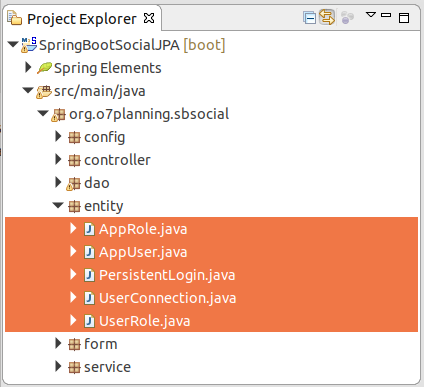
Die Tabelle USERCONNECTION wird nach der Klasse UserConnection erstellt. Die Tabelle wird automatisch durch Spring Social API verwendet. Es speichert die public Information der Benutzer, die vom sozialen Netwerk wie ProviderId, ProviderUserId, Displayname, Imageurl, ... erhaltet. Sie müssen die Struktur der Tabelle nicht ändern.
UserConnection.java
package org.o7planning.sbsocial.entity;
import java.io.Serializable;
import javax.persistence.Column;
import javax.persistence.Entity;
import javax.persistence.Id;
import javax.persistence.Table;
@Entity
@Table(name = "Userconnection")
public class UserConnection implements Serializable {
private static final long serialVersionUID = -6991752510891411572L;
@Id
@Column(name = "Userid", length = 255, nullable = false)
private String userId;
@Id
@Column(name = "Providerid", length = 255, nullable = false)
private String providerId;
@Id
@Column(name = "Provideruserid", length = 255, nullable = false)
private String providerUserId;
@Column(name = "Rank", nullable = false)
private int rank;
@Column(name = "Displayname", length = 255, nullable = true)
private String displayName;
@Column(name = "Profileurl", length = 512, nullable = true)
private String profileUrl;
@Column(name = "Imageurl", length = 512, nullable = true)
private String imageUrl;
@Column(name = "Accesstoken", length = 512, nullable = true)
private String accessToken;
@Column(name = "Secret", length = 512, nullable = true)
private String secret;
@Column(name = "Refreshtoken", length = 512, nullable = true)
private String refreshToken;
@Column(name = "Expiretime", nullable = true)
private Long expireTime;
public String getUserId() {
return userId;
}
public void setUserId(String userId) {
this.userId = userId;
}
public String getProviderId() {
return providerId;
}
public void setProviderId(String providerId) {
this.providerId = providerId;
}
public String getProviderUserId() {
return providerUserId;
}
public void setProviderUserId(String providerUserId) {
this.providerUserId = providerUserId;
}
public int getRank() {
return rank;
}
public void setRank(int rank) {
this.rank = rank;
}
public String getDisplayName() {
return displayName;
}
public void setDisplayName(String displayName) {
this.displayName = displayName;
}
public String getProfileUrl() {
return profileUrl;
}
public void setProfileUrl(String profileUrl) {
this.profileUrl = profileUrl;
}
public String getImageUrl() {
return imageUrl;
}
public void setImageUrl(String imageUrl) {
this.imageUrl = imageUrl;
}
public String getAccessToken() {
return accessToken;
}
public void setAccessToken(String accessToken) {
this.accessToken = accessToken;
}
public String getSecret() {
return secret;
}
public void setSecret(String secret) {
this.secret = secret;
}
public String getRefreshToken() {
return refreshToken;
}
public void setRefreshToken(String refreshToken) {
this.refreshToken = refreshToken;
}
public Long getExpireTime() {
return expireTime;
}
public void setExpireTime(Long expireTime) {
this.expireTime = expireTime;
}
}Die Tabelle PERSISTENT_LOGINS wird nach der Klasse PersistentLogin erstellt. Die Tabelle wird automatisch durchSpring Security Remember Me benutzt. Sie müssen die Struktur der Tabelle nicht ändern.
PersistentLogin.java
package org.o7planning.sbsocial.entity;
import java.util.Date;
import javax.persistence.Column;
import javax.persistence.Entity;
import javax.persistence.Id;
import javax.persistence.Table;
import javax.persistence.Temporal;
import javax.persistence.TemporalType;
@Entity
@Table(name = "persistent_logins")
public class PersistentLogin {
@Id
@Column(name = "Series", length = 64, nullable = false)
private String series;
@Column(name = "Username", length = 64, nullable = false)
private String userName;
@Column(name = "Token", length = 64, nullable = false)
private String token;
@Temporal(TemporalType.TIMESTAMP)
@Column(name = "Last_Used", nullable = false)
private Date lastUsed;
public String getSeries() {
return series;
}
public void setSeries(String series) {
this.series = series;
}
public String getUserName() {
return userName;
}
public void setUserName(String userName) {
this.userName = userName;
}
public String getToken() {
return token;
}
public void setToken(String token) {
this.token = token;
}
public Date getLastUsed() {
return lastUsed;
}
public void setLastUsed(Date lastUsed) {
this.lastUsed = lastUsed;
}
}Die Tabelle APP_USER, APP_ROLE, USER_ROLE werden automatisch nach der Klasse AppUser, AppRole, UserRole erstellt:
AppUser.java
package org.o7planning.sbsocial.entity;
import javax.persistence.Column;
import javax.persistence.Entity;
import javax.persistence.GeneratedValue;
import javax.persistence.Id;
import javax.persistence.Table;
import javax.persistence.UniqueConstraint;
@Entity
@Table(name = "App_User", //
uniqueConstraints = { //
@UniqueConstraint(name = "APP_USER_UK", columnNames = "User_Name"),
@UniqueConstraint(name = "APP_USER_UK2", columnNames = "Email") })
public class AppUser {
@Id
@GeneratedValue
@Column(name = "User_Id", nullable = false)
private Long userId;
@Column(name = "User_Name", length = 36, nullable = false)
private String userName;
@Column(name = "Email", length = 128, nullable = false)
private String email;
@Column(name = "First_Name", length = 36, nullable = true)
private String firstName;
@Column(name = "Last_Name", length = 36, nullable = true)
private String lastName;
@Column(name = "Encryted_Password", length = 128, nullable = false)
private String encrytedPassword;
@Column(name = "Enabled", length = 1, nullable = false)
private boolean enabled;
public Long getUserId() {
return userId;
}
public void setUserId(Long userId) {
this.userId = userId;
}
public String getUserName() {
return userName;
}
public void setUserName(String userName) {
this.userName = userName;
}
public String getEmail() {
return email;
}
public void setEmail(String email) {
this.email = email;
}
public String getFirstName() {
return firstName;
}
public void setFirstName(String firstName) {
this.firstName = firstName;
}
public String getLastName() {
return lastName;
}
public void setLastName(String lastName) {
this.lastName = lastName;
}
public String getEncrytedPassword() {
return encrytedPassword;
}
public void setEncrytedPassword(String encrytedPassword) {
this.encrytedPassword = encrytedPassword;
}
public boolean isEnabled() {
return enabled;
}
public void setEnabled(boolean enabled) {
this.enabled = enabled;
}
}AppRole.java
package org.o7planning.sbsocial.entity;
import javax.persistence.Column;
import javax.persistence.Entity;
import javax.persistence.GeneratedValue;
import javax.persistence.Id;
import javax.persistence.Table;
import javax.persistence.UniqueConstraint;
@Entity
@Table(name = "App_Role", //
uniqueConstraints = { //
@UniqueConstraint(name = "APP_ROLE_UK", columnNames = "Role_Name") })
public class AppRole {
public static final String ROLE_USER = "ROLE_USER";
public static final String ROLE_ADMIN = "ROLE_ADMIN";
@Id
@GeneratedValue
@Column(name = "Role_Id", nullable = false)
private Long roleId;
@Column(name = "Role_Name", length = 30, nullable = false)
private String roleName;
public Long getRoleId() {
return roleId;
}
public void setRoleId(Long roleId) {
this.roleId = roleId;
}
public String getRoleName() {
return roleName;
}
public void setRoleName(String roleName) {
this.roleName = roleName;
}
}UserRole.java
package org.o7planning.sbsocial.entity;
import javax.persistence.Column;
import javax.persistence.Entity;
import javax.persistence.FetchType;
import javax.persistence.GeneratedValue;
import javax.persistence.Id;
import javax.persistence.JoinColumn;
import javax.persistence.ManyToOne;
import javax.persistence.Table;
import javax.persistence.UniqueConstraint;
@Entity
@Table(name = "User_Role", //
uniqueConstraints = { //
@UniqueConstraint(name = "USER_ROLE_UK", //
columnNames = { "User_Id", "Role_Id" }) })
public class UserRole {
@Id
@GeneratedValue
@Column(name = "Id", nullable = false)
private Long id;
@ManyToOne(fetch = FetchType.LAZY)
@JoinColumn(name = "User_Id", nullable = false)
private AppUser appUser;
@ManyToOne(fetch = FetchType.LAZY)
@JoinColumn(name = "Role_Id", nullable = false)
private AppRole appRole;
public Long getId() {
return id;
}
public void setId(Long id) {
this.id = id;
}
public AppUser getAppUser() {
return appUser;
}
public void setAppUser(AppUser appUser) {
this.appUser = appUser;
}
public AppRole getAppRole() {
return appRole;
}
public void setAppRole(AppRole appRole) {
this.appRole = appRole;
}
}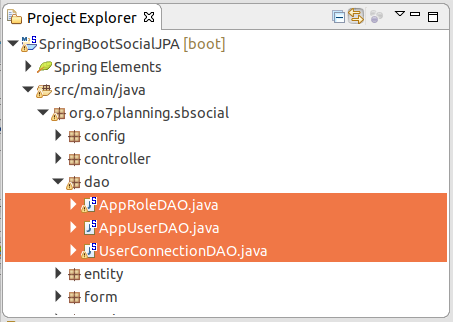
AppUserDAO.java
package org.o7planning.sbsocial.dao;
import java.util.ArrayList;
import java.util.List;
import java.util.UUID;
import javax.persistence.EntityManager;
import javax.persistence.NoResultException;
import javax.persistence.Query;
import org.o7planning.sbsocial.entity.AppRole;
import org.o7planning.sbsocial.entity.AppUser;
import org.o7planning.sbsocial.form.AppUserForm;
import org.o7planning.sbsocial.utils.EncrytedPasswordUtils;
import org.springframework.beans.factory.annotation.Autowired;
import org.springframework.social.connect.Connection;
import org.springframework.social.connect.ConnectionKey;
import org.springframework.social.connect.UserProfile;
import org.springframework.stereotype.Repository;
import org.springframework.transaction.annotation.Transactional;
@Repository
@Transactional
public class AppUserDAO {
@Autowired
private EntityManager entityManager;
@Autowired
private AppRoleDAO appRoleDAO;
public AppUser findAppUserByUserId(Long userId) {
try {
String sql = "Select e from " + AppUser.class.getName() + " e " //
+ " Where e.userId = :userId ";
Query query = entityManager.createQuery(sql, AppUser.class);
query.setParameter("userId", userId);
return (AppUser) query.getSingleResult();
} catch (NoResultException e) {
return null;
}
}
public AppUser findAppUserByUserName(String userName) {
try {
String sql = "Select e from " + AppUser.class.getName() + " e " //
+ " Where e.userName = :userName ";
Query query = entityManager.createQuery(sql, AppUser.class);
query.setParameter("userName", userName);
return (AppUser) query.getSingleResult();
} catch (NoResultException e) {
return null;
}
}
public AppUser findByEmail(String email) {
try {
String sql = "Select e from " + AppUser.class.getName() + " e " //
+ " Where e.email = :email ";
Query query = entityManager.createQuery(sql, AppUser.class);
query.setParameter("email", email);
return (AppUser) query.getSingleResult();
} catch (NoResultException e) {
return null;
}
}
private String findAvailableUserName(String userName_prefix) {
AppUser account = this.findAppUserByUserName(userName_prefix);
if (account == null) {
return userName_prefix;
}
int i = 0;
while (true) {
String userName = userName_prefix + "_" + i++;
account = this.findAppUserByUserName(userName);
if (account == null) {
return userName;
}
}
}
// Auto create App User Account.
public AppUser createAppUser(Connection<?> connection) {
ConnectionKey key = connection.getKey();
// (facebook,12345), (google,123) ...
System.out.println("key= (" + key.getProviderId() + "," + key.getProviderUserId() + ")");
UserProfile userProfile = connection.fetchUserProfile();
String email = userProfile.getEmail();
AppUser appUser = this.findByEmail(email);
if (appUser != null) {
return appUser;
}
String userName_prefix = userProfile.getFirstName().trim().toLowerCase()//
+ "_" + userProfile.getLastName().trim().toLowerCase();
String userName = this.findAvailableUserName(userName_prefix);
//
// Random Password! TODO: Need send email to User!
//
String randomPassword = UUID.randomUUID().toString().substring(0, 5);
String encrytedPassword = EncrytedPasswordUtils.encrytePassword(randomPassword);
//
appUser = new AppUser();
appUser.setEnabled(true);
appUser.setEncrytedPassword(encrytedPassword);
appUser.setUserName(userName);
appUser.setEmail(email);
appUser.setFirstName(userProfile.getFirstName());
appUser.setLastName(userProfile.getLastName());
this.entityManager.persist(appUser);
// Create default Role
List<String> roleNames = new ArrayList<String>();
roleNames.add(AppRole.ROLE_USER);
this.appRoleDAO.createRoleFor(appUser, roleNames);
return appUser;
}
public AppUser registerNewUserAccount(AppUserForm appUserForm, List<String> roleNames) {
AppUser appUser = new AppUser();
appUser.setUserName(appUserForm.getUserName());
appUser.setEmail(appUserForm.getEmail());
appUser.setFirstName(appUserForm.getFirstName());
appUser.setLastName(appUserForm.getLastName());
appUser.setEnabled(true);
String encrytedPassword = EncrytedPasswordUtils.encrytePassword(appUserForm.getPassword());
appUser.setEncrytedPassword(encrytedPassword);
this.entityManager.persist(appUser);
this.entityManager.flush();
this.appRoleDAO.createRoleFor(appUser, roleNames);
return appUser;
}
}AppRoleDAO.java
package org.o7planning.sbsocial.dao;
import java.util.List;
import javax.persistence.EntityManager;
import javax.persistence.NoResultException;
import javax.persistence.Query;
import org.o7planning.sbsocial.entity.AppRole;
import org.o7planning.sbsocial.entity.AppUser;
import org.o7planning.sbsocial.entity.UserRole;
import org.springframework.beans.factory.annotation.Autowired;
import org.springframework.stereotype.Repository;
import org.springframework.transaction.annotation.Transactional;
@Repository
@Transactional
public class AppRoleDAO {
@Autowired
private EntityManager entityManager;
public List<String> getRoleNames(Long userId) {
String sql = "Select ur.appRole.roleName from " + UserRole.class.getName() + " ur " //
+ " where ur.appUser.userId = :userId ";
Query query = this.entityManager.createQuery(sql, String.class);
query.setParameter("userId", userId);
return query.getResultList();
}
public AppRole findAppRoleByName(String roleName) {
try {
String sql = "Select e from " + AppRole.class.getName() + " e " //
+ " where e.roleName = :roleName ";
Query query = this.entityManager.createQuery(sql, AppRole.class);
query.setParameter("roleName", roleName);
return (AppRole) query.getSingleResult();
} catch (NoResultException e) {
return null;
}
}
public void createRoleFor(AppUser appUser, List<String> roleNames) {
//
for (String roleName : roleNames) {
AppRole role = this.findAppRoleByName(roleName);
if (role == null) {
role = new AppRole();
role.setRoleName(AppRole.ROLE_USER);
this.entityManager.persist(role);
this.entityManager.flush();
}
UserRole userRole = new UserRole();
userRole.setAppRole(role);
userRole.setAppUser(appUser);
this.entityManager.persist(userRole);
this.entityManager.flush();
}
}
}UserConnectionDAO.java
package org.o7planning.sbsocial.dao;
import java.util.List;
import javax.persistence.EntityManager;
import javax.persistence.NoResultException;
import javax.persistence.Query;
import org.o7planning.sbsocial.entity.UserConnection;
import org.springframework.beans.factory.annotation.Autowired;
import org.springframework.stereotype.Repository;
import org.springframework.transaction.annotation.Transactional;
@Repository
@Transactional
public class UserConnectionDAO {
@Autowired
private EntityManager entityManager;
public UserConnection findUserConnectionByUserProviderId(String userProviderId) {
try {
String sql = "Select e from " + UserConnection.class.getName() + " e " //
+ " Where e.userProviderId = :userProviderId ";
Query query = entityManager.createQuery(sql, UserConnection.class);
query.setParameter("userProviderId", userProviderId);
List<UserConnection> list = query.getResultList();
return list.isEmpty() ? null : list.get(0);
} catch (NoResultException e) {
return null;
}
}
}6. Services & Utility
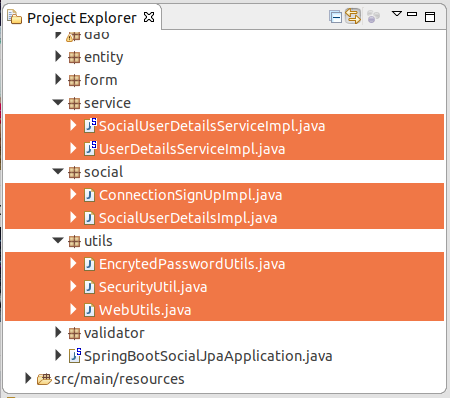
UserDetailsServiceImpl.java
package org.o7planning.sbsocial.service;
import java.util.ArrayList;
import java.util.List;
import org.o7planning.sbsocial.dao.AppRoleDAO;
import org.o7planning.sbsocial.dao.AppUserDAO;
import org.o7planning.sbsocial.entity.AppUser;
import org.o7planning.sbsocial.social.SocialUserDetailsImpl;
import org.springframework.beans.factory.annotation.Autowired;
import org.springframework.security.core.GrantedAuthority;
import org.springframework.security.core.authority.SimpleGrantedAuthority;
import org.springframework.security.core.userdetails.UserDetails;
import org.springframework.security.core.userdetails.UserDetailsService;
import org.springframework.security.core.userdetails.UsernameNotFoundException;
import org.springframework.stereotype.Service;
import org.springframework.transaction.annotation.Transactional;
@Service
@Transactional
public class UserDetailsServiceImpl implements UserDetailsService {
@Autowired
private AppUserDAO appUserDAO;
@Autowired
private AppRoleDAO appRoleDAO;
@Override
public UserDetails loadUserByUsername(String userName) throws UsernameNotFoundException {
System.out.println("UserDetailsServiceImpl.loadUserByUsername=" + userName);
AppUser appUser = this.appUserDAO.findAppUserByUserName(userName);
if (appUser == null) {
System.out.println("User not found! " + userName);
throw new UsernameNotFoundException("User " + userName + " was not found in the database");
}
System.out.println("Found User: " + appUser);
// [ROLE_USER, ROLE_ADMIN,..]
List<String> roleNames = this.appRoleDAO.getRoleNames(appUser.getUserId());
List<GrantedAuthority> grantList = new ArrayList<GrantedAuthority>();
if (roleNames != null) {
for (String role : roleNames) {
// ROLE_USER, ROLE_ADMIN,..
GrantedAuthority authority = new SimpleGrantedAuthority(role);
grantList.add(authority);
}
}
SocialUserDetailsImpl userDetails = new SocialUserDetailsImpl(appUser, roleNames);
return userDetails;
}
}SocialUserDetailsServiceImpl.java
package org.o7planning.sbsocial.service;
import org.o7planning.sbsocial.social.SocialUserDetailsImpl;
import org.springframework.beans.factory.annotation.Autowired;
import org.springframework.dao.DataAccessException;
import org.springframework.security.core.userdetails.UserDetails;
import org.springframework.security.core.userdetails.UserDetailsService;
import org.springframework.security.core.userdetails.UsernameNotFoundException;
import org.springframework.social.security.SocialUserDetails;
import org.springframework.social.security.SocialUserDetailsService;
import org.springframework.stereotype.Service;
@Service
public class SocialUserDetailsServiceImpl implements SocialUserDetailsService {
@Autowired
private UserDetailsService userDetailService;
// After user created by ConnectionSignUpImpl.execute(Connection<?>)
// This method is called by the Spring Social API.
@Override
public SocialUserDetails loadUserByUserId(String userName) throws UsernameNotFoundException, DataAccessException {
System.out.println("SocialUserDetailsServiceImpl.loadUserByUserId=" + userName);
// See UserDetailServiceImpl.
UserDetails userDetails = ((UserDetailsServiceImpl) userDetailService).loadUserByUsername(userName);
return (SocialUserDetailsImpl) userDetails;
}
}Wenn der Benutzer zum ersten Mal mit seinem soziales Netwerk Konto anmeldet, wird die Applikation ein Objekt Connection haben. Das Objekt die Profil (Profile) des Benutzers. Sie werden die Kode in der Klasse ConnectionSignUpImpl schreiben um ein Rekord der Tabelle APP_USER zu erstellen. (die Kode in die Klasse SocialConfig schauen).
ConnectionSignUpImpl.java
package org.o7planning.sbsocial.social;
import org.o7planning.sbsocial.dao.AppUserDAO;
import org.o7planning.sbsocial.entity.AppUser;
import org.springframework.social.connect.Connection;
import org.springframework.social.connect.ConnectionSignUp;
public class ConnectionSignUpImpl implements ConnectionSignUp {
private AppUserDAO appUserDAO;
public ConnectionSignUpImpl(AppUserDAO appUserDAO) {
this.appUserDAO = appUserDAO;
}
// After logging in social networking.
// This method will be called to create a corresponding App_User record
// if it does not already exist.
@Override
public String execute(Connection<?> connection) {
AppUser account = appUserDAO.createAppUser(connection);
return account.getUserName();
}
}SocialUserDetailsImpl.java
package org.o7planning.sbsocial.social;
import java.util.ArrayList;
import java.util.Collection;
import java.util.List;
import org.o7planning.sbsocial.entity.AppUser;
import org.springframework.security.core.GrantedAuthority;
import org.springframework.security.core.authority.SimpleGrantedAuthority;
import org.springframework.social.security.SocialUserDetails;
public class SocialUserDetailsImpl implements SocialUserDetails {
private static final long serialVersionUID = -5246117266247684905L;
private List<GrantedAuthority> list = new ArrayList<GrantedAuthority>();
private AppUser appUser;
public SocialUserDetailsImpl(AppUser appUser, List<String> roleNames) {
this.appUser = appUser;
for (String roleName : roleNames) {
GrantedAuthority grant = new SimpleGrantedAuthority(roleName );
this.list.add(grant);
}
}
@Override
public String getUserId() {
return this.appUser.getUserId() + "";
}
@Override
public String getUsername() {
return appUser.getUserName();
}
@Override
public Collection<? extends GrantedAuthority> getAuthorities() {
return list;
}
@Override
public String getPassword() {
return appUser.getEncrytedPassword();
}
@Override
public boolean isAccountNonExpired() {
return true;
}
@Override
public boolean isAccountNonLocked() {
return true;
}
@Override
public boolean isCredentialsNonExpired() {
return true;
}
@Override
public boolean isEnabled() {
return true;
}
}EncrytedPasswordUtils.java
package org.o7planning.sbsocial.utils;
import org.springframework.security.crypto.bcrypt.BCryptPasswordEncoder;
public class EncrytedPasswordUtils {
// Encryte Password with BCryptPasswordEncoder
public static String encrytePassword(String password) {
BCryptPasswordEncoder encoder = new BCryptPasswordEncoder();
return encoder.encode(password);
}
}Die Klasse SecurityUtil erhaltet die Utility Methode enthalten um automatisch einen Benutzer in die Applikation anzumelden
SecurityUtil.java
package org.o7planning.sbsocial.utils;
import java.util.List;
import org.o7planning.sbsocial.entity.AppUser;
import org.o7planning.sbsocial.social.SocialUserDetailsImpl;
import org.springframework.security.authentication.UsernamePasswordAuthenticationToken;
import org.springframework.security.core.Authentication;
import org.springframework.security.core.context.SecurityContextHolder;
import org.springframework.social.security.SocialUserDetails;
public class SecurityUtil {
// Auto Login.
public static void logInUser(AppUser user, List<String> roleNames) {
SocialUserDetails userDetails = new SocialUserDetailsImpl(user, roleNames);
Authentication authentication = new UsernamePasswordAuthenticationToken(userDetails, null,
userDetails.getAuthorities());
SecurityContextHolder.getContext().setAuthentication(authentication);
}
}WebUtils.java
package org.o7planning.sbsocial.utils;
import java.util.Collection;
import org.springframework.security.core.GrantedAuthority;
import org.springframework.security.core.userdetails.UserDetails;
public class WebUtils {
public static String toString(UserDetails user) {
StringBuilder sb = new StringBuilder();
sb.append("UserName:").append(user.getUsername());
Collection<? extends GrantedAuthority> authorities = user.getAuthorities();
if (authorities != null && !authorities.isEmpty()) {
sb.append(" (");
boolean first = true;
for (GrantedAuthority a : authorities) {
if (first) {
sb.append(a.getAuthority());
first = false;
} else {
sb.append(", ").append(a.getAuthority());
}
}
sb.append(")");
}
return sb.toString();
}
}7. Form, Validator, Controller
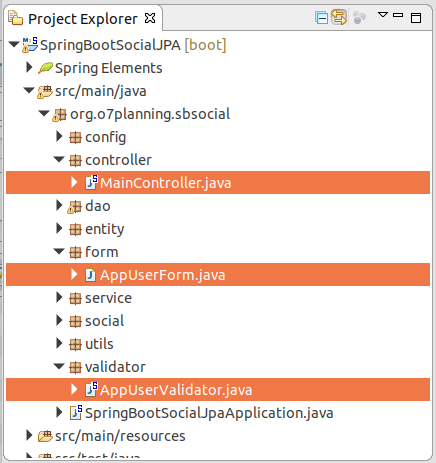
AppUserForm ist eine Klasse zur Vertretung der Daten, die der Benutzer bei der Registration eines neuen Konto eingibt
AppUserForm.java
package org.o7planning.sbsocial.form;
import org.springframework.social.connect.Connection;
import org.springframework.social.connect.ConnectionKey;
import org.springframework.social.connect.UserProfile;
public class AppUserForm {
private Long userId;
private String email;
private String userName;
private String firstName;
private String lastName;
private String password;
private String role;
private String signInProvider;
private String providerUserId;
public AppUserForm() {
}
public AppUserForm(Connection<?> connection) {
UserProfile socialUserProfile = connection.fetchUserProfile();
this.userId = null;
this.email = socialUserProfile.getEmail();
this.userName = socialUserProfile.getUsername();
this.firstName = socialUserProfile.getFirstName();
this.lastName = socialUserProfile.getLastName();
ConnectionKey key = connection.getKey();
// google, facebook, twitter
this.signInProvider = key.getProviderId();
// ID of User on google, facebook, twitter.
// ID của User trên google, facebook, twitter.
this.providerUserId = key.getProviderUserId();
}
public Long getUserId() {
return userId;
}
public void setUserId(Long id) {
this.userId = id;
}
public String getEmail() {
return email;
}
public void setEmail(String email) {
this.email = email;
}
public String getUserName() {
return userName;
}
public void setUserName(String userName) {
this.userName = userName;
}
public String getFirstName() {
return firstName;
}
public void setFirstName(String firstName) {
this.firstName = firstName;
}
public String getLastName() {
return lastName;
}
public void setLastName(String lastName) {
this.lastName = lastName;
}
public String getPassword() {
return password;
}
public void setPassword(String password) {
this.password = password;
}
public String getRole() {
return role;
}
public void setRole(String role) {
this.role = role;
}
public String getSignInProvider() {
return signInProvider;
}
public void setSignInProvider(String signInProvider) {
this.signInProvider = signInProvider;
}
public String getProviderUserId() {
return providerUserId;
}
public void setProviderUserId(String providerUserId) {
this.providerUserId = providerUserId;
}
}AppUserFormValidator wird verwendet um die vom Benutzer eingegebenen Daten bei der Registration eines neuen Konto zu prüfen.
AppUserValidator.java
package org.o7planning.sbsocial.validator;
import org.apache.commons.validator.routines.EmailValidator;
import org.o7planning.sbsocial.dao.AppUserDAO;
import org.o7planning.sbsocial.entity.AppUser;
import org.o7planning.sbsocial.form.AppUserForm;
import org.springframework.beans.factory.annotation.Autowired;
import org.springframework.stereotype.Component;
import org.springframework.validation.Errors;
import org.springframework.validation.ValidationUtils;
import org.springframework.validation.Validator;
@Component
public class AppUserValidator implements Validator {
// common-validator library.
private EmailValidator emailValidator = EmailValidator.getInstance();
@Autowired
private AppUserDAO appUserDAO;
@Override
public boolean supports(Class<?> clazz) {
return clazz == AppUserForm.class;
}
@Override
public void validate(Object target, Errors errors) {
AppUserForm form = (AppUserForm) target;
ValidationUtils.rejectIfEmptyOrWhitespace(errors, "email", "", "Email is required");
ValidationUtils.rejectIfEmptyOrWhitespace(errors, "userName", "", "User name is required");
ValidationUtils.rejectIfEmptyOrWhitespace(errors, "firstName", "", "First name is required");
ValidationUtils.rejectIfEmptyOrWhitespace(errors, "lastName", "", "Last name is required");
ValidationUtils.rejectIfEmptyOrWhitespace(errors, "password", "", "Password is required");
if (errors.hasErrors()) {
return;
}
if (!emailValidator.isValid(form.getEmail())) {
errors.rejectValue("email", "", "Email is not valid");
return;
}
AppUser userAccount = appUserDAO.findAppUserByUserName( form.getUserName());
if (userAccount != null) {
if (form.getUserId() == null) {
errors.rejectValue("userName", "", "User name is not available");
return;
} else if (!form.getUserId().equals(userAccount.getUserId() )) {
errors.rejectValue("userName", "", "User name is not available");
return;
}
}
userAccount = appUserDAO.findByEmail(form.getEmail());
if (userAccount != null) {
if (form.getUserId() == null) {
errors.rejectValue("email", "", "Email is not available");
return;
} else if (!form.getUserId().equals(userAccount.getUserId() )) {
errors.rejectValue("email", "", "Email is not available");
return;
}
}
}
}MainController.java
package org.o7planning.sbsocial.controller;
import java.security.Principal;
import java.util.ArrayList;
import java.util.List;
import org.o7planning.sbsocial.dao.AppUserDAO;
import org.o7planning.sbsocial.entity.AppRole;
import org.o7planning.sbsocial.entity.AppUser;
import org.o7planning.sbsocial.form.AppUserForm;
import org.o7planning.sbsocial.utils.SecurityUtil;
import org.o7planning.sbsocial.utils.WebUtils;
import org.o7planning.sbsocial.validator.AppUserValidator;
import org.springframework.beans.factory.annotation.Autowired;
import org.springframework.security.core.Authentication;
import org.springframework.security.core.userdetails.User;
import org.springframework.security.core.userdetails.UserDetails;
import org.springframework.social.connect.Connection;
import org.springframework.social.connect.ConnectionFactoryLocator;
import org.springframework.social.connect.UsersConnectionRepository;
import org.springframework.social.connect.web.ProviderSignInUtils;
import org.springframework.stereotype.Controller;
import org.springframework.transaction.annotation.Transactional;
import org.springframework.ui.Model;
import org.springframework.validation.BindingResult;
import org.springframework.validation.annotation.Validated;
import org.springframework.web.bind.WebDataBinder;
import org.springframework.web.bind.annotation.InitBinder;
import org.springframework.web.bind.annotation.ModelAttribute;
import org.springframework.web.bind.annotation.RequestMapping;
import org.springframework.web.bind.annotation.RequestMethod;
import org.springframework.web.context.request.WebRequest;
import org.springframework.web.servlet.mvc.support.RedirectAttributes;
@Controller
@Transactional
public class MainController {
@Autowired
private AppUserDAO appUserDAO;
@Autowired
private ConnectionFactoryLocator connectionFactoryLocator;
@Autowired
private UsersConnectionRepository connectionRepository;
@Autowired
private AppUserValidator appUserValidator;
@InitBinder
protected void initBinder(WebDataBinder dataBinder) {
// Form target
Object target = dataBinder.getTarget();
if (target == null) {
return;
}
System.out.println("Target=" + target);
if (target.getClass() == AppUserForm.class) {
dataBinder.setValidator(appUserValidator);
}
// ...
}
@RequestMapping(value = { "/", "/welcome" }, method = RequestMethod.GET)
public String welcomePage(Model model) {
model.addAttribute("title", "Welcome");
model.addAttribute("message", "This is welcome page!");
return "welcomePage";
}
@RequestMapping(value = "/admin", method = RequestMethod.GET)
public String adminPage(Model model, Principal principal) {
// After user login successfully.
String userName = principal.getName();
System.out.println("User Name: " + userName);
UserDetails loginedUser = (UserDetails) ((Authentication) principal).getPrincipal();
String userInfo = WebUtils.toString(loginedUser);
model.addAttribute("userInfo", userInfo);
return "adminPage";
}
@RequestMapping(value = "/logoutSuccessful", method = RequestMethod.GET)
public String logoutSuccessfulPage(Model model) {
model.addAttribute("title", "Logout");
return "logoutSuccessfulPage";
}
@RequestMapping(value = "/userInfo", method = RequestMethod.GET)
public String userInfo(Model model, Principal principal) {
// After user login successfully.
String userName = principal.getName();
System.out.println("User Name: " + userName);
UserDetails loginedUser = (UserDetails) ((Authentication) principal).getPrincipal();
String userInfo = WebUtils.toString(loginedUser);
model.addAttribute("userInfo", userInfo);
return "userInfoPage";
}
@RequestMapping(value = "/403", method = RequestMethod.GET)
public String accessDenied(Model model, Principal principal) {
if (principal != null) {
UserDetails loginedUser = (UserDetails) ((Authentication) principal).getPrincipal();
String userInfo = WebUtils.toString(loginedUser);
model.addAttribute("userInfo", userInfo);
String message = "Hi " + principal.getName() //
+ "<br> You do not have permission to access this page!";
model.addAttribute("message", message);
}
return "403Page";
}
@RequestMapping(value = { "/login" }, method = RequestMethod.GET)
public String login(Model model) {
return "loginPage";
}
// User login with social networking,
// but does not allow the app to view basic information
// application will redirect to page / signin.
@RequestMapping(value = { "/signin" }, method = RequestMethod.GET)
public String signInPage(Model model) {
return "redirect:/login";
}
@RequestMapping(value = { "/signup" }, method = RequestMethod.GET)
public String signupPage(WebRequest request, Model model) {
ProviderSignInUtils providerSignInUtils //
= new ProviderSignInUtils(connectionFactoryLocator, connectionRepository);
// Retrieve social networking information.
Connection<?> connection = providerSignInUtils.getConnectionFromSession(request);
//
AppUserForm myForm = null;
//
if (connection != null) {
myForm = new AppUserForm(connection);
} else {
myForm = new AppUserForm();
}
model.addAttribute("myForm", myForm);
return "signupPage";
}
@RequestMapping(value = { "/signup" }, method = RequestMethod.POST)
public String signupSave(WebRequest request, //
Model model, //
@ModelAttribute("myForm") @Validated AppUserForm appUserForm, //
BindingResult result, //
final RedirectAttributes redirectAttributes) {
// Validation error.
if (result.hasErrors()) {
return "signupPage";
}
List<String> roleNames = new ArrayList<String>();
roleNames.add(AppRole.ROLE_USER);
AppUser registered = null;
try {
registered = appUserDAO.registerNewUserAccount(appUserForm, roleNames);
} catch (Exception ex) {
ex.printStackTrace();
model.addAttribute("errorMessage", "Error " + ex.getMessage());
return "signupPage";
}
if (appUserForm.getSignInProvider() != null) {
ProviderSignInUtils providerSignInUtils //
= new ProviderSignInUtils(connectionFactoryLocator, connectionRepository);
// (Spring Social API):
// If user login by social networking.
// This method saves social networking information to the UserConnection table.
providerSignInUtils.doPostSignUp(registered.getUserName(), request);
}
// After registration is complete, automatic login.
SecurityUtil.logInUser(registered, roleNames);
return "redirect:/userInfo";
}
}8. View (Thymeleaf)
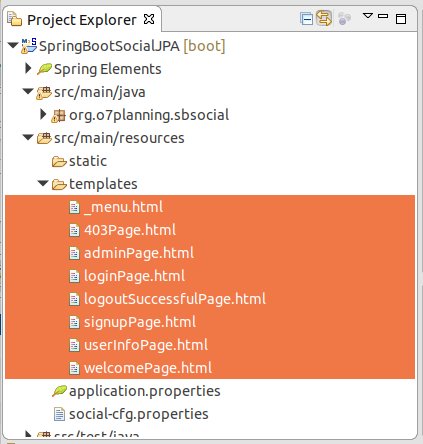
_menu.html
<div xmlns:th="http://www.thymeleaf.org"
style="border: 1px solid #ccc;padding:5px;margin-bottom:20px;">
<a th:href="@{/}">Home</a>
|
<a th:href="@{/userInfo}">User Info</a>
|
<a th:href="@{/admin}">Admin</a>
|
<a th:if="${#request.userPrincipal != null}" th:href="@{/logout}">Logout</a>
</div>403Page.html
<!DOCTYPE HTML>
<html xmlns:th="http://www.thymeleaf.org">
<head>
<title>Access Denied</title>
</head>
<body>
<!-- Include _menu.html -->
<th:block th:include="/_menu"></th:block>
<h3 th:if="${message != null}" th:utext="${message}" style="color: red;"></h3>
<div th:if="${userInfo != null}" th:utext="${userInfo}"></div>
</body>
</html>adminPage.html
<!DOCTYPE HTML>
<html xmlns:th="http://www.thymeleaf.org">
<head>
<title th:utext="${title}"></title>
</head>
<body>
<!-- Include _menu.html -->
<th:block th:include="/_menu"></th:block>
<h2>Admin Page</h2>
<h3>Welcome :
<span th:utext="${#request.userPrincipal.name}"></span>
</h3>
<b>This is protected page!</b>
<br/><br/>
<div th:if="${userInfo != null}" th:utext="${userInfo}"></div>
</body>
</html>loginPage.html
<!DOCTYPE HTML>
<html xmlns:th="http://www.thymeleaf.org">
<head>
<title>Login</title>
</head>
<body>
<!-- Include _menu.html -->
<th:block th:include="/_menu"></th:block>
<h1>Login</h1>
<h2>Social Login</h2>
<a th:href="@{/auth/facebook}">Face Book</a>
<br />
<a th:href="@{/auth/google}">Google</a>
<br />
<!-- /login?error=true -->
<div th:if="${#request.getParameter('error') == 'true'}"
style="color:red;margin:10px 0px;">
Login Failed!!!<br />
Reason :
<span th:if="${#session!= null and #session.getAttribute('SPRING_SECURITY_LAST_EXCEPTION') != null}"
th:utext="${#session.getAttribute('SPRING_SECURITY_LAST_EXCEPTION').message}">
Static summary
</span>
</div>
<h3>Enter user name and password:</h3>
<form name='f' th:action="@{/j_spring_security_check}" method='POST'>
<table>
<tr>
<td>User:</td>
<td><input type='text' name='username' value=''></td>
</tr>
<tr>
<td>Password:</td>
<td><input type='password' name='password' /></td>
</tr>
<tr>
<td>Remember Me?</td>
<td><input type="checkbox" name="remember-me" /></td>
</tr>
<tr>
<td><input name="submit" type="submit" value="submit" /></td>
</tr>
</table>
</form>
<br>
Username/pass:
<ul>
<li>dbuser1/123</li>
<li>dbadmin1/123</li>
</ul>
</body>
</html>loginSuccessfulPage.html
<!DOCTYPE HTML>
<html xmlns:th="http://www.thymeleaf.org">
<head>
<title>Logout</title>
</head>
<body>
<!-- Include _menu.html -->
<th:block th:include="/_menu"></th:block>
<h1>Logout Successful!</h1>
</body>
</html>signupPage.html
<!DOCTYPE HTML>
<html xmlns:th="http://www.thymeleaf.org">
<head>
<meta charset="UTF-8">
<title>Sign Up</title>
<style>
.error-message {
font-size:90%;
font-style:italic;
color:red;
}
</style>
</head>
<body>
<!-- Include _menu.html -->
<th:block th:include="/_menu"></th:block>
<h1>Register</h1>
<h2 style="color:blue;"
th:if="${myForm.signInProvider != null}">Signup with <span th:utex="${myForm.signInProvider}"></span></h2>
<form th:object="${myForm}" method="POST">
<input type="hidden" th:field="*{userId}" />
<input type="hidden" th:field="*{signInProvider}" />
<table border="0">
<tr>
<td>User Name</td>
<td><input th:field="*{userName}" /></td>
<td>
<span class="error-message"
th:if="${#fields.hasErrors('userName')}" th:errors="*{userName}">..</span>
</td>
</tr>
<tr>
<td>Email</td>
<td><input th:field="*{email}" /></td>
<td>
<span class="error-message"
th:if="${#fields.hasErrors('email')}" th:errors="*{email}">..</span>
</td>
</tr>
<tr>
<td>First Name</td>
<td><input th:field="*{firstName}" /></td>
<td>
<span class="error-message"
th:if="${#fields.hasErrors('firstName')}" th:errors="*{firstName}">..</span>
</td>
</tr>
<tr>
<td>Last Name</td>
<td><input th:field="*{lastName}" /></td>
<td>
<span class="error-message"
th:if="${#fields.hasErrors('lastName')}" th:errors="*{lastName}">..</span>
</td>
</tr>
<tr>
<td>Password</td>
<td><input th:field="*{password}" /></td>
<td>
<span class="error-message"
th:if="${#fields.hasErrors('password')}" th:errors="*{password}">..</span>
</td>
</tr>
<tr>
<td></td>
<td><input type="submit" value="Submit" /></td>
<td></td>
</tr>
</table>
</form>
<div class="error-message" th:utext="${errorMessage}"></div>
</body>
</html>userInfoPage.html
<!DOCTYPE HTML>
<html xmlns:th="http://www.thymeleaf.org">
<head>
<title>User Info</title>
</head>
<body>
<!-- Include _menu.html -->
<th:block th:include="/_menu"></th:block>
<h2>User Info Page</h2>
<h3>Welcome : <span th:utext="${#request.userPrincipal.name}"></span></h3>
<b>This is protected page!</b>
<br/><br/>
<div th:if="${userInfo != null}" th:utext="${userInfo}"></div>
</body>
</html>welcomePage.html
<!DOCTYPE HTML>
<html xmlns:th="http://www.thymeleaf.org">
<head>
<title th:utext="${title}"></title>
</head>
<body>
<!-- Include _menu.html -->
<th:block th:include="/_menu"></th:block>
<h2>Message : <span th:utext="${message}"></span></h2>
</body>
</html>No ADS
Anleitungen Spring Boot
- Installieren Sie die Spring Tool Suite für Eclipse
- Die Anleitung zum Sping für den Anfänger
- Die Anleitung zum Spring Boot für den Anfänger
- Gemeinsame Eigenschaften von Spring Boot
- Die Anleitung zu Spring Boot und Thymeleaf
- Die Anleitung zu Spring Boot und FreeMarker
- Die Anleitung zu Spring Boot und Groovy
- Die Anleitung zu Spring Boot und Mustache
- Die Anleitung zu Spring Boot und JSP
- Die Anleitung zu Spring Boot, Apache Tiles, JSP
- Verwenden Sie Logging im Spring Boot
- Anwendungsüberwachung mit Spring Boot Actuator
- Erstellen Sie eine mehrsprachige Webanwendung mit Spring Boot
- Verwenden Sie im Spring Boot mehrere ViewResolver
- Verwenden Sie Twitter Bootstrap im Spring Boot
- Die Anleitung zu Spring Boot Interceptor
- Die Anleitung zu Spring Boot, Spring JDBC und Spring Transaction
- Die Anleitung zu Spring JDBC
- Die Anleitung zu Spring Boot, JPA und Spring Transaction
- Die Anleitung zu Spring Boot und Spring Data JPA
- Die Anleitung zu Spring Boot, Hibernate und Spring Transaction
- Spring Boot, JPA und H2-Datenbank integrieren
- Die Anleitung zu Spring Boot und MongoDB
- Verwenden Sie mehrere DataSource mit Spring Boot und JPA
- Verwenden Sie mehrere DataSource mit Spring Boot und RoutingDataSource
- Erstellen Sie eine Login-Anwendung mit Spring Boot, Spring Security, Spring JDBC
- Erstellen Sie eine Login-Anwendung mit Spring Boot, Spring Security, JPA
- Erstellen Sie eine Benutzerregistrierungsanwendung mit Spring Boot, Spring Form Validation
- Beispiel für OAuth2 Social Login im Spring Boot
- Führen Sie geplante Hintergrundaufgaben in Spring aus
- CRUD Restful Web Service Beispiel mit Spring Boot
- Beispiel Spring Boot Restful Client mit RestTemplate
- CRUD-Beispiel mit Spring Boot, REST und AngularJS
- Sichere Spring Boot RESTful Service mit Basic Authentication
- Sicherer Spring Boot RESTful Service mit Auth0 JWT
- Beispiel Upload file mit Spring Boot
- Beispiel Download File mit Spring Boot
- Das Beispiel: Spring Boot File Upload mit jQuery Ajax
- Das Beispiel File Upload mit Spring Boot und AngularJS
- Erstellen Sie eine Warenkorb-Webanwendung mit Spring Boot, Hibernate
- Die Anleitung zu Spring Email
- Erstellen Sie eine einfache Chat-Anwendung mit Spring Boot und Websocket
- Stellen Sie die Spring Boot-Anwendung auf Tomcat Server bereit
- Stellen Sie die Spring Boot-Anwendung auf Oracle WebLogic Server bereit
- Installieren Sie ein kostenloses Let's Encrypt SSL-Zertifikat für Spring Boot
- Konfigurieren Sie Spring Boot so, dass HTTP zu HTTPS umgeleitet wird
Show More